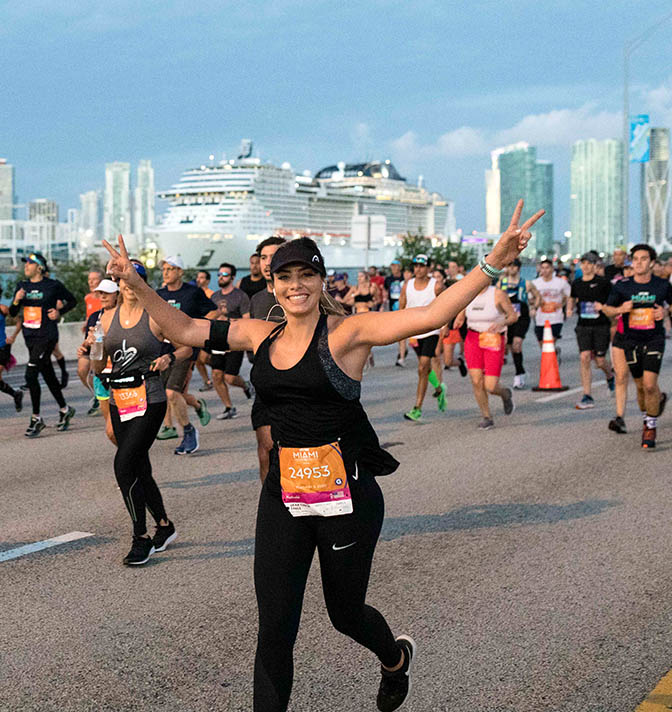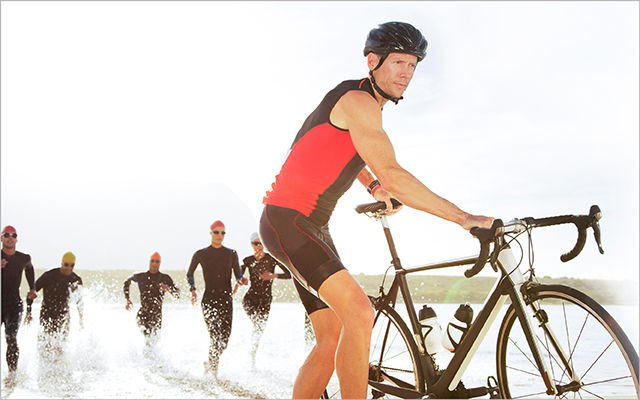From the moment I saw the New York City Marathon, in 1997, I was hooked. I was amazed by the breadth of athletes — the powerful elite runners and ordinary people like me — running 26.2 miles. So, I tracked down a training regimen on the internet and, a year later, I completed my first marathon.
The accomplishment made me euphoric, as did all the hard work that led up to the race.
I have plenty of company in my quest to push my athleticism to new levels. There’s been a rise of everyday athletes in recent years: accountants, real-estate brokers, nurses, marketers, and everyone in between who are also cyclists, skiers, power lifters, mountaineers — you name it. They’re all challenging their physical and mental limits as they pursue their passions.
“We thrive off wanting to be better,” explains sports-performance expert DeVentri Jordan, MS, USAW, NASM-CPT. Jordan is the founder of and national director of performance for GameFace Training, a Life Time initiative that develops customized performance programs for aspiring athletes. “People love to win, and they like to find ways to relieve stress — working out and being the best at what they’re doing help accomplish that.”
Nearly 7 million Americans adopted new activities like hiking and biking in 2020, according to the Sports and Fitness Industry Association. The pandemic pushed people to select outdoor sports such as running and cycling, which naturally lend themselves to goal-setting and tap into the intrinsic motivation to keep going — a key element of athletic success.
“People love to win, and they like to find ways to relieve stress — working out and being the best at what they’re doing help accomplish that.”
Plus, Instagram and other social platforms expose us to others’ incredible accomplishments — and spark our curiosity about our own potential.
More people than ever are now pursuing elite levels of athleticism. Global marathon participation was up 50 percent in the decade preceding the COVID-19 pandemic. Participation in ultrarunning events has grown 345 percent in the past decade.
Other athletic pursuits have grown in popularity as well, including gravel racing, competitive weightlifting, and women’s elite-level bicycle racing.
I am proud to count myself among such athletes: I ran more events in the years following that first marathon, even setting the New York state record for the Masters Mile and winning Vermont’s Green Mountain Marathon. There was no stopping me.
Or so it seemed.
One day, I found myself barely able to tie my sneakers. Weak, exhausted, and confused, I soon discovered I was suffering from overtraining. It wasn’t caused solely by running; I was also working a full-time job, serving as a volunteer firefighter, and raising two children.
The passion to perform had pushed me to my limits. And that wasn’t necessarily a good thing.
Pushing the Limits
There is a mythology around elite-level training — a sense of power in reaching and surpassing limits to achieve potential beyond our imaginations. If athletes are modern-day gods, it is a pinnacle of human achievement to stand among them.
But this mythology insinuates that training hard is everything. It doesn’t account for the rest of real life — the responsibilities, obligations, and relationships that make up the priorities and stressors we grapple with every day.
Excelling at a sport does not happen in a vacuum. All of the stress in our lives — even good stress — adds up. Whether it comes from physical stressors (exercise load, workload, or loads of laundry) or mental and emotional stressors (personal relationships or our relationship to the world around us), stress can wear us down. So it’s important to be mindful of how you’re pushing yourself with your training in light of the cumulative effect of everything else in your life.
“The trick is learning what works for us as individuals, especially as we factor in full-time jobs, families, and life outside of training.”
Elite athletes and their coaches know this. Stress reconciliation is key to their achievement: They get better because they prioritize recovery. The physical stresses of exercise break athletes down; recovery through active rest, nutrition, sleep, meditation, bodywork, and more rebuilds them better than before. (See “The Recovery Zone” to discover the signs of when it may be time to give your body a break and how to come back stronger.)
But how many everyday athletes focus on stress reconciliation? How many even consider the impact of other priorities on training? How many of us squeeze in our training whenever, wherever, and however we can, sacrificing sleep, warm-ups, cool-downs, and active rest in order to train and live — in order to do it all?
It is possible to balance passion for a sport or activity with the responsibilities of day-to-day life without burning out. “The trick,” says Ben Walker, a personal trainer and sports-mindset coach based in Dublin, Ireland, “is learning what works for us as individuals, especially as we factor in full-time jobs, families, and life outside of training.”
Walker and other experts shed light on the everyday athlete and how to find balance as we lift heavy, run fast, and shoot for the stars.
The Why of Working Out
Balancing our training and nontraining lives starts with developing a mindset focused on why we are working so hard at a sport or activity in the first place.
We seem to love to excel physically. A large part of our adaptation as humans was based on play: using vigorous, lighthearted, and exploratory movement as a source of fun, fulfillment, and purpose, explains Frank Forencich, founder of the Exuberant Animal wellness organization. Athletics grew from that drive.
Through the relentless pursuit of our passions, we tap into our historic power. For one thing, it’s simply fun to perform feats of strength, whether we’re competing in an Olympic arena or on our local pickleball court.
But the benefits of pursuing a sport aren’t limited to honoring our human nature. The boons are physical, psychological, and social — and your unique why may be a confluence of these rewards.
We are made to move, and the gains of physical activity can be felt in every part of the body. Exercise has been shown to lower blood pressure, reduce heart-disease risk, and strengthen the cardiovascular system. Weight-bearing activities like basketball, strength training, running, and skiing are associated with building and maintaining strong bones and muscles.
Exercising also improves our brains, making us smarter, happier, and more resilient. Sport can heighten our alertness and perception, reinforce movement patterns and coordination, and enhance attention and concentration. It aids learning and memory, supports mental health, protects against cognitive decline, and keeps the brain “young.”
“Sport gives people the opportunity to have community — to belong somewhere, to be a part of something.”
Training and competing can increase energy while easing anxiety and amplifying mental focus. Exercise helps regulate cortisol production, making it a useful way to blow off steam and reduce chronic stress.
Other benefits include improvements in gastrointestinal and immune health as well as overall quality of life. (Learn more about all the great reasons to move your body at “The Benefits of Moving Your Body“.)
“There are so many positive things that come from this level of discipline,” says Marc Hodulich, an endurance athlete, Ironman triathlete, and cofounder and CEO of 29029 Everesting, which directs participants up the vertical equivalent of Mt. Everest at North American ski resorts.
“On a fundamental level, it feels good to go after and achieve big goals, and for those goals to shift over the course of our lives,” says Barbara Powell, MA, NBC-HWC, holistic coach for Life Time Mind, a performance-coaching program. “It’s quite human to set the bar for ourselves to move toward, and once we get there, to move the goalpost once again, further out.”
Challenges help people socialize and communicate as they complete tasks together or compete head-to-head. They also boost personal skills by promoting teamwork and teaching us to handle pressure and think critically. Practicing a sport or exercising helps build self-efficacy and confidence, as well as patience.
“Sport gives people the opportunity to have community — to belong somewhere, to be a part of something,” says Jordan.
So why is it important to consider the why — or whys — in your athletic training?
“If we don’t know what’s important to us, it can be a lot easier to fall into the trap of what we think training hard should be like,” says Powell. “It benefits us to check in with ourselves to determine: What else do I have going on in my life that requires my attention? How can I best integrate who I am, what’s important to me, and how I want my life to unfold?”
The Steep Cost of a Great Thing
The hurdles that many everyday athletes encounter are typically where they were originally experiencing the benefits.
Overtraining is a chief obstacle. That’s because one of the misconceptions of training like an elite athlete is that you push nonstop, which is how many of us run into trouble. We often neglect the real work of recovery and reconciling stress from other parts of our lives.
“Training like an athlete focuses on constantly increasing your aerobic and anaerobic threshold,” says Walker. “This is done progressively through steady-state and intense exercise. This is built up over time so that an athlete isn’t pushing too hard and is still within their limits so they can recover. Pushing too hard becomes a factor when you haven’t built up this threshold enough.”
Training can break down our bodies, as countless everyday athletes discover. Symptoms of overtraining include prolonged and unusually sore muscles, poor sleep, crankiness, recovery delays, and low performance.
If you’re stressed at work or home, then you don’t get as good of a workout, because your body can’t perform.”
We can slip into depression as our energy dissipates, too. “Even elite athletes must honor their bodies, minds, and priorities as best they can. We can be an athlete and be human, too,” says Powell.
Tech can track recovery data and alert you to your needs. Powell, who’s also a long-distance endurance athlete, uses the Whoop band, which helps track recovery with metrics like heart-rate variability.
“I appreciate the wisdom of our individual bodies, which can alert us to signs of overextending ourselves when we pay attention,” she adds. “I have the phrase temet nosce — know thyself — tattooed on my wrist as a reminder. When I get irritable or wake up more tired than I fell asleep feeling, or experience an easy-paced run as difficult, those are telltale signs for me that rest is needed.”
Experts agree that there are three key factors to avoiding overtraining.
1. Nutrition
Tracking macronutrients — especially protein — can help you maintain fitness and reach the next level in your training. The International Society of Sports Nutrition and the National Academy of Sports Medicine offer the following guidelines:
- For adults seeking to improve their endurance: 0.5 to 0.6 grams of protein per pound of body weight per day. This equates to 75 to 90 grams of protein daily for a 150-pound person.
- For adults trying to build muscle and strength: 0.6 to 0.9 grams of protein per pound of body weight per day. This works out to 90 to 135 grams of protein daily for a 150-pound person.
(For more on the power of protein, see “Protein Power: What You Need to Know“.)
2. Sleep
Studies have shown that more shuteye results in better performance. So, instead of staying up late or setting your alarm for an early workout, give yourself the gift of an extra hour or two of sleep. (For more on the benefits of sleep and tips on sleeping better, see “How Does Sleep Influence Weight Gain?“.)
3. Stress Management
Stress saps energy, focus, and mood, so we need to consciously manage it. “If you’re stressed at work or home, then you don’t get as good of a workout, because your body can’t perform,” says Hodulich. Adjust your workouts based on your daily stress levels.
Nowadays, when a big deadline is looming, I dial back on my miles, and I go harder at the gym when I have a lag in work projects. Deep breathing and visualization can help mitigate stressors in life. (For more on how stress can affect your performance, see “The Science of Stress“.)
The Life–Sport Balancing Act
When we’re training for an event, we everyday athletes sometimes act as if we’re the center of the universe. “Many people think when they work toward a huge athletic goal, everything should orbit around them — and that’s OK, for a bit,” says Hodulich. “But it’s equally important to look around at the rest of your life.”
The focus on pushing nonstop can take a toll on your social life — and not just because your training schedule might cause you to miss a happy hour or weekend brunch.
“You can become quite selfish,” he cautions. “If you’re neglecting family or business — and possibly even your teammates — that’s the biggest possible downside and warning that something is off. It’s critical to find balance.”
Hodulich learned this firsthand after training for an Ironman competition. He admits to neglecting his wife for six months. “She said, ‘You can choose — more Ironmans, or more me time.’”
A major downside of pushing your body is that you might push everything else away. “You chase that high — the feeling at that finish line for something you worked six, nine, or 12 months for, and it’s indescribable; it leaves you wanting more of it,” Hodulich says. “At the same time, if you continue to chase it, it can become an addiction.” (For more on this, see “What Is a Behavioral Addiction?“.)
A path toward balance involves setting goals that consider all parts of your life, whether that’s relationships, family time, work, or education.
“There is an essential skillset of knowing the difference between neglecting and boundary-building.”
“There is an essential skillset of knowing the difference between neglecting and boundary-building,” says Powell. “Am I neglecting my values for this? Or am I building healthy boundaries to support my values?”
Even Powell says it’s not easy. “Some days I get it right; some days I don’t. I simply do my best to check in with what’s important to me.”
Setting realistic goals can be game-changing for aspiring athletes, adds Jordan. “I tell my athletes we have to begin with the end in mind. Where do you want to be? What do you want to become? And we work backward from there.
“So, if you want to be an elite athlete,” he continues, “we look at what it takes to get there, what our approach will be, and how much time, realistically, you’re able to put into it.”
As for me, I’ve learned over time the importance of balancing my love of fitness with my love of life. I’ve reduced the number and intensity of races I enter. I’ve resigned from some stressors, such as firefighting. And I’ve focused on rest and recovery through good nutrition and my new passion: dancing.
Now, my gym time is mostly reserved for practicing ridiculously fun hip-hop moves to ’90s dance songs, an activity my teenage kids can do, too. And I feel the same sense of euphoria I once felt during marathon training — discovering that the real power and control I have in my life is not so much in my muscles, but in my mind.
5 Ways to Train Like an Athlete
Going all out, 24/7, 365 days a year, is a direct route to hitting a brick wall.
Whether they’re physical stressors from a workout, mental stressors from a big work project, or emotional stressors from a relationship issue, stress factors meld to wear us down. “Being aware of the stress in your life and how your body reacts to it can lead to a greater awareness of what rest and recovery is needed for continued resiliency,” advises Life Time Mind coach Barbara Powell.
Powell and other experts share advice on becoming a better athlete through cultivating a better perspective on being a human — and not just a human body.
1. Practice Recovery
Rest and recovery are essential for athletic performance. Training breaks down your body, which responds by building itself back up better than before — but only if you give it enough recovery time. (For more on rest and recovery, see “The Recovery Zone“.)
Powell breaks down recovery into three categories: micro, macro, and habitual.
- Microrecovery is what we can do in “tiny moments throughout the day to tend to our bodies and minds,” she says. This might be pausing to do a breathing exercise; orienting ourselves by drawing our eyes away from screens and toward nature; noticing our posture and making a tiny adjustment; or hugging someone who supports and loves us.
- Macrorecovery is what we usually think of when we take a break and rest. “This may be going on a weeklong vacation,” Powell explains. “It may be a weekend free of social media or technology. It may be the deload week in training. It is a deep, restorative time away from the ongoing work we are in the midst of — athletic or simply life or both!”
Habitual recovery is daily mindfulness practices, stretching or yoga, cold-water plunges, talk therapy or coaching sessions, gathering with family or friends, nutrition and hydration, proper sleep, and so on. “What we habitually do to support our well-being and recover from workouts and the stresses of life creates ongoing resiliency,” she says.
One easy habitual recovery practice is myofascial release, which is great for soothing tight muscle groups, says trainer Ben Walker. He suggests foam-rolling glutes, quads, hamstrings, and the lower and upper back to help lubricate the fascia, which can reduce inflammation and increase circulation and range of motion.
2. Fuel Yourself
Counterintuitively, training can diminish your appetite, making it easy to skip meals. Even without doing the protein math, you can rely on the fact that consuming about 20 grams of protein after a workout promotes muscle growth and repair.
Also, aim for a steady supply of water, which is essential to cellular function, all day — whether or not you’re training. (For more on hydration, see “Everything You Need to Know About Hydration“.)
3. Schedule Workouts
“Mapping your workouts is key for success,” says Walker. “By planning ahead, you can split your workouts and target muscle groups and endurance exercises without missing them from your agenda. You can be organized on your recovery time, making sure you’re ready to train body parts again within a 24- to 48-hour window.
“This is important for anyone who’s looking to progressively make gains. It also gives you the means to create a SMART goal: By creating a timeline of your workout schedule, you can judge whether a certain goal can be specific, measurable, attainable, and relevant within a certain time frame.”
Walker says that creating a schedule and sharing it with loved ones can give you the peace of mind you need to focus on training.
4. Perform Compound Movements
Lunges, hang cleans, high pulls, jump squats, and other compound moves can help you not only excel in your sport but also functionally handle the demands of everyday life, explains sports-performance expert DeVentri Jordan.
Walker concurs. “Compound movements are beneficial, as they work two muscle groups at once. This keeps the muscle tissues burning more calories, because more fibers are active. By practicing more compound movements, we can improve our functional health more effectively than doing singular movements. By having the muscle groups assist each other to complete a movement pattern, it promotes better agility and mobility.”
5. Build Movement Into Your Life
“Treat movement as medicine and make wise choices to stay active on a daily basis,” says Walker. “Instead of driving everywhere or taking the bus, jog, walk, or cycle to destinations during your working day. Instead of taking the elevator, take the stairs. Discover new ways to keep your metabolism active throughout the course of the day.” Remember, the primal and primary purpose of athleticism is fun!






This Post Has One Comment
Thank you for the article — I like the tip about compound movements. As a distance runner I am always looking for better ways to stay strong during training.